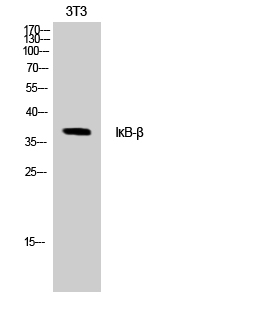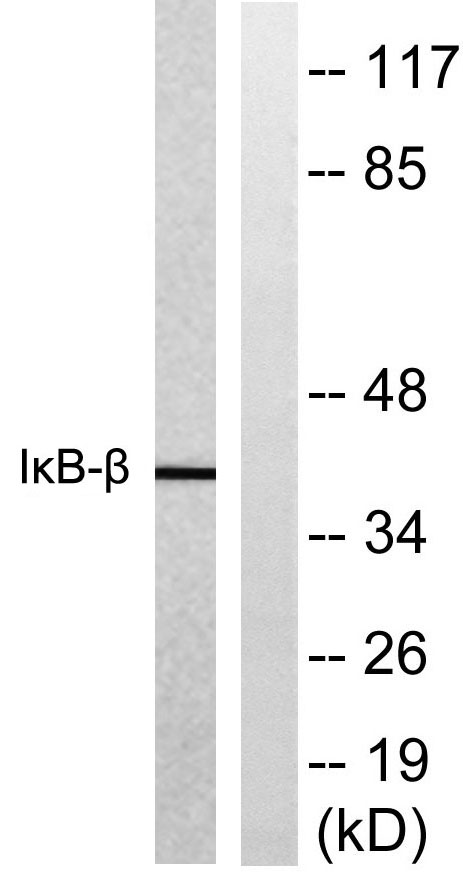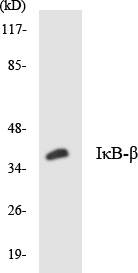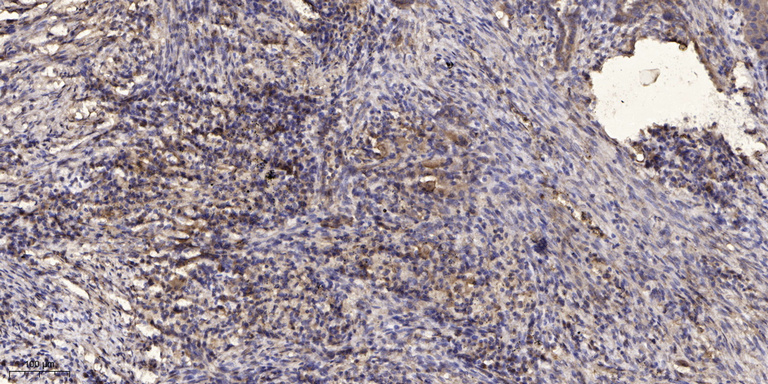IκB-β Polyclonal Antibody
- Catalog No.:YT2421
- Applications:WB;IHC
- Reactivity:Human;Mouse
- Target:
- IκB β
- Fields:
- >>Chemokine signaling pathway;>>NOD-like receptor signaling pathway;>>RIG-I-like receptor signaling pathway;>>Cytosolic DNA-sensing pathway;>>Th1 and Th2 cell differentiation;>>Th17 cell differentiation;>>T cell receptor signaling pathway;>>B cell receptor signaling pathway;>>Neurotrophin signaling pathway;>>Adipocytokine signaling pathway;>>Pathogenic Escherichia coli infection;>>Shigellosis;>>Leishmaniasis;>>Toxoplasmosis;>>Measles;>>Influenza A;>>Epstein-Barr virus infection;>>Coronavirus disease - COVID-19;>>PD-L1 expression and PD-1 checkpoint pathway in cancer
- Gene Name:
- NFKBIB
- Protein Name:
- NF-kappa-B inhibitor beta
- Human Gene Id:
- 4793
- Human Swiss Prot No:
- Q15653
- Mouse Gene Id:
- 18036
- Mouse Swiss Prot No:
- Q60778
- Immunogen:
- The antiserum was produced against synthesized peptide derived from human IkappaB-beta. AA range:4-53
- Specificity:
- IκB-β Polyclonal Antibody detects endogenous levels of IκB-β protein.
- Formulation:
- Liquid in PBS containing 50% glycerol, 0.5% BSA and 0.02% sodium azide.
- Source:
- Polyclonal, Rabbit,IgG
- Dilution:
- WB 1:500-2000;IHC 1:50-300
- Purification:
- The antibody was affinity-purified from rabbit antiserum by affinity-chromatography using epitope-specific immunogen.
- Concentration:
- 1 mg/ml
- Storage Stability:
- -15°C to -25°C/1 year(Do not lower than -25°C)
- Other Name:
- NFKBIB;IKBB;TRIP9;NF-kappa-B inhibitor beta;NF-kappa-BIB;I-kappa-B-beta;IkB-B;IkB-beta;IkappaBbeta;Thyroid receptor-interacting protein 9;TR-interacting protein 9;TRIP-9
- Observed Band(KD):
- 37kD
- Background:
- The protein encoded by this gene belongs to the NF-kappa-B inhibitor family, which inhibit NF-kappa-B by complexing with, and trapping it in the cytoplasm. Phosphorylation of serine residues on these proteins by kinases marks them for destruction via the ubiquitination pathway, thereby allowing activation of the NF-kappa-B, which translocates to the nucleus to function as a transcription factor. Alternatively spliced transcript variants have been found for this gene.[provided by RefSeq, Jul 2011],
- Function:
- function:Inhibits NF-kappa-B by complexing with and trapping it in the cytoplasm. However, the unphosphorylated form resynthesized after cell stimulation is able to bind NF-kappa-B allowing its transport to the nucleus and protecting it to further IKBA-dependent inactivation. Association with inhibitor kappa B-interacting NKIRAS1 and NKIRAS2 prevent its phosphorylation rendering it more resistant to degradation, explaining its slower degradation.,PTM:Phosphorylated; followed by degradation. Interaction with NKIRAS1 and NKIRAS2 probably prevents phosphorylation.,similarity:Belongs to the NF-kappa-B inhibitor family.,similarity:Contains 6 ANK repeats.,subunit:Interacts with THRB (via ligand-binding domain). Interacts with RELA and REL. Interacts with COMMD1 and inhibitor kappa B-interacting Ras-like NKIRAS1 and NKIRAS2.,tissue specificity:Expressed in all tissues examined.,
- Subcellular Location:
- Cytoplasm . Nucleus .
- Expression:
- Expressed in all tissues examined.
- June 19-2018
- WESTERN IMMUNOBLOTTING PROTOCOL
- June 19-2018
- IMMUNOHISTOCHEMISTRY-PARAFFIN PROTOCOL
- June 19-2018
- IMMUNOFLUORESCENCE PROTOCOL
- September 08-2020
- FLOW-CYTOMEYRT-PROTOCOL
- May 20-2022
- Cell-Based ELISA│解您多样本WB检测之困扰
- July 13-2018
- CELL-BASED-ELISA-PROTOCOL-FOR-ACETYL-PROTEIN
- July 13-2018
- CELL-BASED-ELISA-PROTOCOL-FOR-PHOSPHO-PROTEIN
- July 13-2018
- Antibody-FAQs
- Products Images

- Western Blot analysis of NIH-3T3 cells using IκB-β Polyclonal Antibody

- Western blot analysis of lysates from NIH/3T3 cells, treated with TNF 20ng/ml 30', using IkappaB-beta Antibody. The lane on the right is blocked with the synthesized peptide.

- Western blot analysis of the lysates from HT-29 cells using IκB-β antibody.

- Immunohistochemical analysis of paraffin-embedded human Squamous cell carcinoma of lung. 1, Antibody was diluted at 1:200(4° overnight). 2, Tris-EDTA,pH9.0 was used for antigen retrieval. 3,Secondary antibody was diluted at 1:200(room temperature, 45min).



